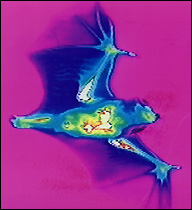![]()
Departments
![]()

|
Week of 14 May 1999 |
Vol. II, No. 34 |
Feature Article
Radar now tracking bat traffic
By Hope Green
At dusk, Mexican free-tailed bats by the millions emerge from caves and forage the Hill Country outside San Antonio and Austin, Texas. Depending on the season, females of the species nightly consume up to half their body weight in insects, including many notorious agricultural pests.
Ecologists have long assumed that Tadarida brasiliensis mexicana provides an enormous service to humans by devouring such crop pillagers as corn earworm moths and potato beetles. Until now, however, the bats' economic value has been difficult to quantify. Absent a reliable method to census the animals, an intriguing equation has gone unsolved: as measured in crops protected and money saved on chemical pesticides and fertilizer, how much do these organic pest-controllers contribute to agricultural productivity?
Determined to answer this and related questions, Thomas Kunz, CAS biology professor, director of BU's Center for Ecology and Conservation Biology, and noted bat specialist, is leading a three-year interdisciplinary study under a grant from the National Science Foundation (NSF). The research team will use advanced computer technology to count and monitor the bats and then combine its findings with existing agricultural data to develop an economic-impact model. "In the final analysis," explains Kunz, "we hope the model will allow us to place a dollar value on the ecosystem services provided by these bats, because people are used to thinking about value in terms of dollars. We expect to find that protecting bats -- nature's own pest-control service -- is more cost-effective than using pesticides."
The project is part of a recently established NSF program known as computational biology. "Our study, in large part, can now be conducted because of recent developments in microelectronics and computer technology," says Kunz. "We are using emerging technologies to answer biological questions that we couldn't answer only a few years ago."
Joining Kunz in the study are Cutler Cleveland, CAS associate professor of geography and director of BU's Center for Energy and Environmental Studies, and Jeff Frank, a computer engineer and vice president of Indigo Systems Corporation in Santa Barbara, Calif. In June, the researchers will begin to gather data on bat populations from three major caves in south-central Texas. They will use infrared thermal imaging to census the bats as they set out from the caves each night, and Doppler radar imaging to chart their dispersal patterns across farm lands.
Employing geographic information systems mapping, the scientists will then combine the census and spatial information with existing calculations of pesticide and fertilizer use, along with data that Kunz has previously documented on bat feeding habits, to create their economic-impact model.
|
|
|
A false-color digital thermal image of a flying bat, with the hottest parts of the body and wings shown in white and the coolest parts in dark blue. Photo courtesy of Thomas Kunz |
Past attempts by scientists to census the bats have all failed, Kunz says, largely because of the difficulty of observing these flying animals at night. Infrared thermal imaging, however, makes it possible to detect moving objects by the heat they generate, regardless of available light, and produces a digital image that can be readily distinguished from its background.
Frank, a colleague of Kunz, originally developed the infrared technology for military use but is adapting it for the study of ecology and natural history. The imaging system is able to detect individual bats as they fly past the field of view of a camera, and then relay this information digitally to a computer. At BU, graduate and undergraduate students will assist with data analysis and model building.
Doppler radar, the other imaging system in the study, was developed to monitor military air traffic. "Since then, it has improved tremendously, and is now used at every airport worldwide," says Kunz. "It is also used by meteorologists to track cloud patterns and storms, and sometimes by biologists to track the migration of birds and movements of bats." In Kunz's study, researchers will be able to capture and download the Doppler radar images of dispersing bats and use the data to analyze how the animals move over the agricultural landscape.
Technology for ecology
Both technologies hold extraordinary promise for
other wildlife conservation studies, Kunz says. Doppler
radar can be used to analyze bird migratory patterns, for
instance, and infrared imaging can help to census all kinds
of birds, seals, and four-legged mammals. Infrared imaging
systems -- by depicting warmer and colder parts of organisms
in false-color patterns -- also have potential applications
for investigating thermo-regulatory responses of animals to
changing environments.
In the near term, Kunz hopes his research on the Mexican freetailed bats will help to build a case for protecting these misunderstood winged mammals and their natural habitats, "so that they will continue to provide natural pest-control services to help sustain healthy ecosystems.
"The economic cost of applying millions of tons of pesticides to agricultural crops each year is staggering," he says. "These costs are associated not only with the manufacture and application of pesticides, but also with the detrimental effects they have on the environment, including habitat degradation and the increased health-care costs to humans associated with pesticide exposure."
